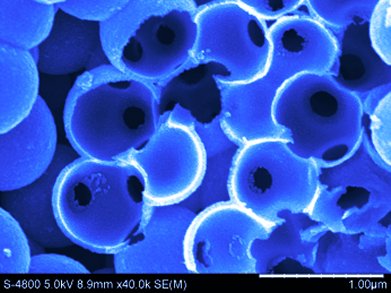Tuning the morphology and structure of titania can improve its photocatalytic efficiency. The low density, excellent surface permeability, tunable pore structure, and high light-harvesting efficiency of carbon-doped titania hollow spheres (THS) make for an excellent photocatalyst.
The groups of Ming-Lai Fu, Chinese Academy of Sciences, Fujian, and Lianzhou Wang, University of Queensland, Australia, prepared THS from carbon spheres and titanium isopropoxide by using simple centrifugation and dispersion techniques.
Interconnection of the mesoporous sphere walls in the THS gave a hierarchical macroporous channel structure with excellent photocatalytic performance. THS photocatalyzed the decoloration of methyl orange (MO) under visible light irradiation with 94 % efficiency over one hour. This was much higher than that of the titania powder sample used as a comparison (ca. 14 % efficiency).
Residual carbon photosensitized the THS and small-scale carbon doping caused band gap narrowing. •OH radicals produced from OH– groups trapped in photogenerated holes may also have aided catalysis. The channel structure facilitated diffusion of MO molecules and multiple light reflections, enhancing light harvesting. Facile separation of the THS was followed by retention of the high photocatalytic activity after six runs.
Image: © Wiley-VCH
- Carbon-doped Titania Hollow Spheres with Tunable Hierarchical Macroporous Channels and Enhanced Visible Light-induced Photocatalytic Activity,
J.-W. Shi, X. Zong, X. Wu, H.-J. Cui, B. Xu, L. Wang, M.-L. Fu,
ChemCatChem 2012, 4, 488–491.
DOI: 10.1002/cctc.201200019 - View all ChemViews articles related to this journal




